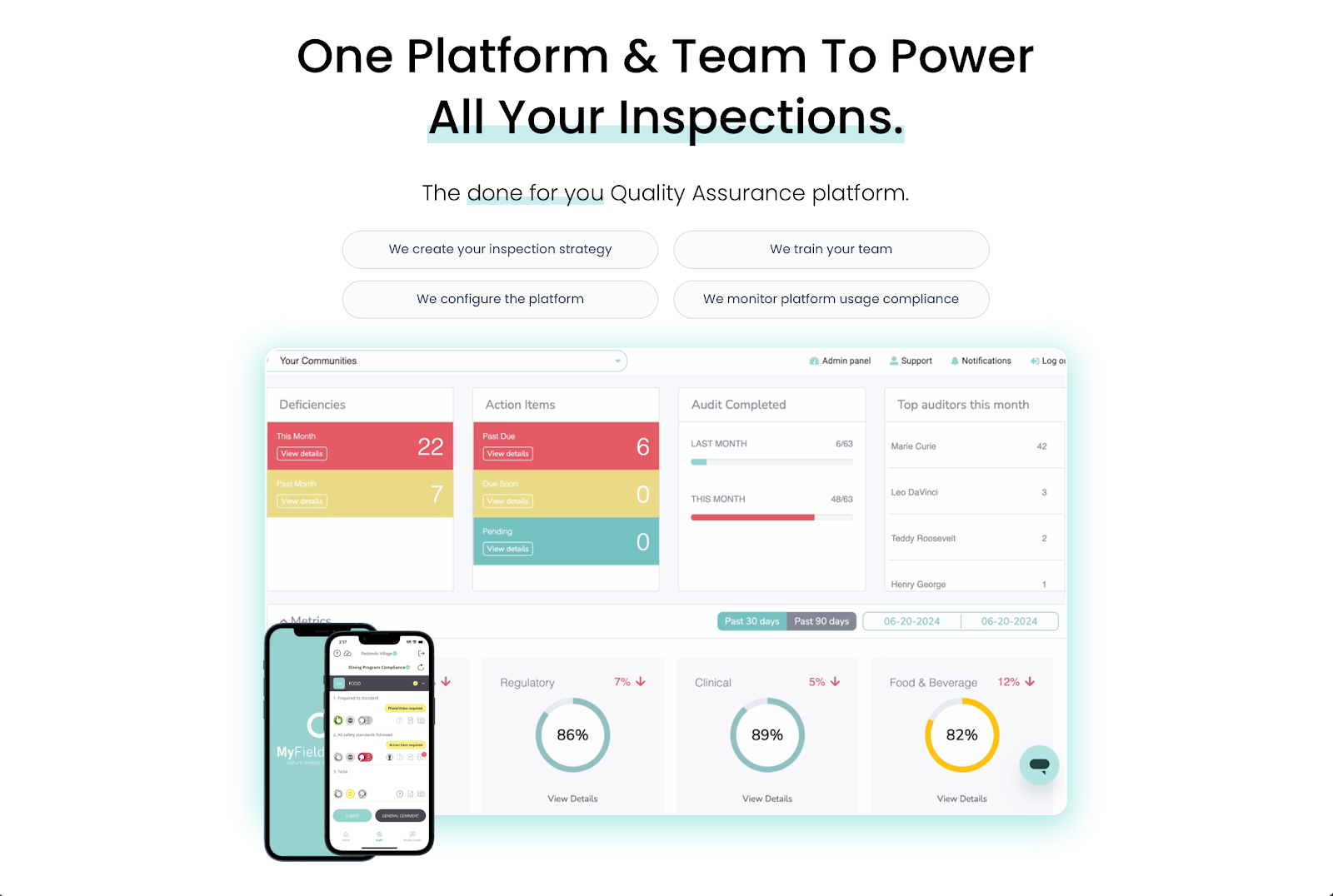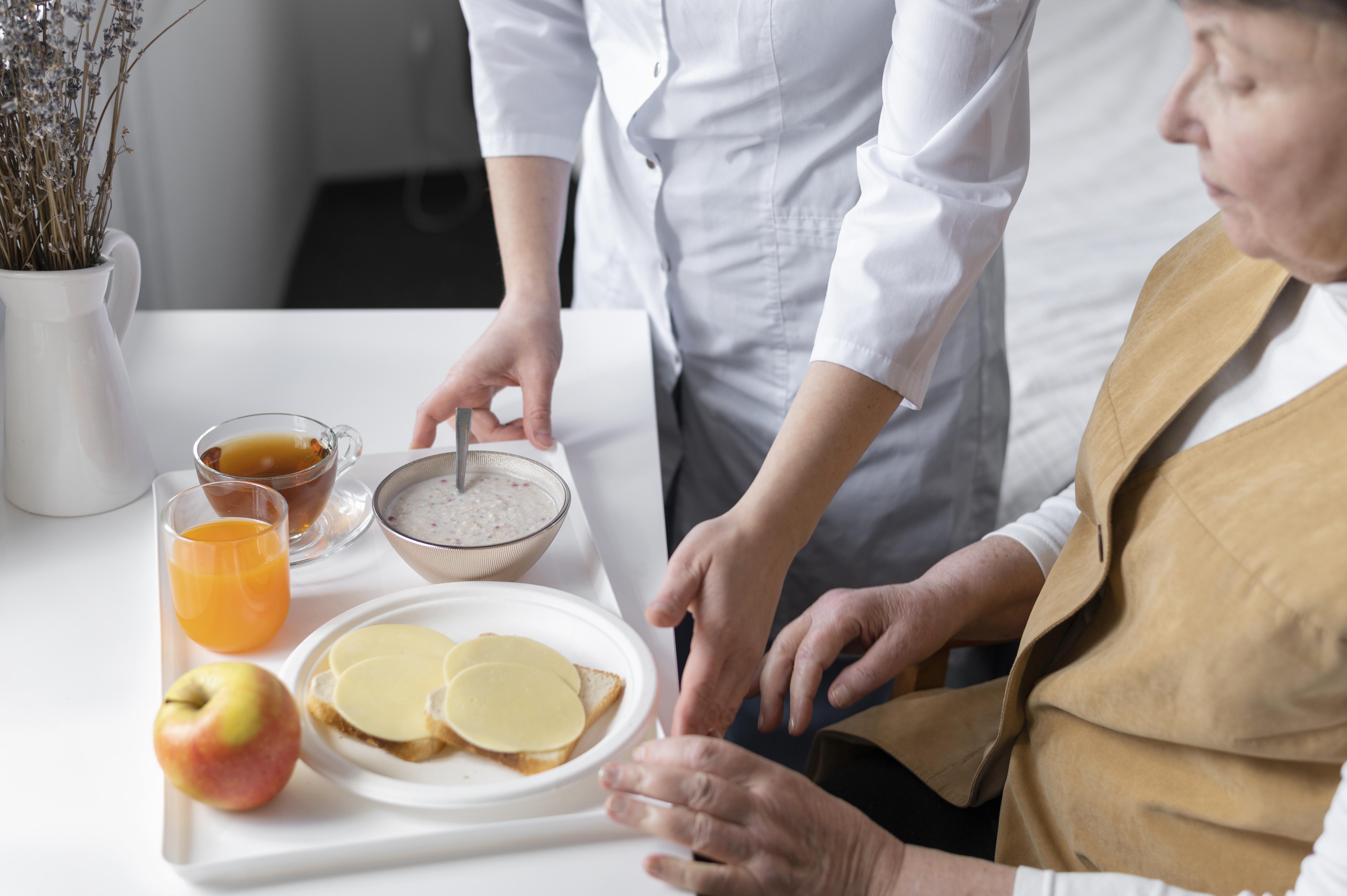.svg)
How to Create Effective Food Standard Operating Procedures

Take Control of QA.
Make Inspections Effortless.

We’ll quickly uncover your needs and share how we can help—no pressure, no stress, just solutions. Grab your spot on our calendar today!
Running a food service management company involves more than following recipes and delivering good service. You need clear systems to keep teams aligned, reduce risks, and maintain consistent food safety standards every day.
Food standard operating procedures (SOPs) tell your staff exactly how to carry out daily tasks, from food preparation to closing duties.
With SOPs in place, your operations run smoothly, training becomes easier, and you meet food compliance requirements across multiple locations.
In this guide, we’ll share step-by-step instructions for creating effective SOPs. We'll also cover their definition, types, and benefits below.
What Are Food Standard Operating Procedures?
Food standard operating procedures are written practices that outline how your employees should perform specific tasks in a kitchen or restaurant.
These tasks can include cooking, cleaning, food storage, waste disposal, or using certain equipment.
SOPs break down each key component clearly to prevent confusion. They make sure every task gets done the same way, no matter who is working that day.
Types of SOPs in the Food Business
Different food businesses follow varying written procedures for various aspects of operations. For example, SOPs and quality control in restaurants differ from those in the food manufacturing industry.
Here are the most common types of food standard operating procedures:
- Food safety SOPs: These cover tasks like handwashing, cross-contamination prevention, and safe food temperatures. Effective food safety practices can support disease control by preventing foodborne illnesses and making sure your restaurant maintains its "A" grade.
- HACCP-focused SOPs: These involve creating food safety programs that follow Hazard Analysis and Critical Control Point (HACCP) standards.
- Food service SOPs: They focus on front-of-house tasks such as taking orders, serving food, and handling customer complaints. They help create a consistent guest experience. In food production or manufacturing facilities, the food service manager ensures consistency in portioning, batch processing, and packaging.
- Food quality and compliance SOPs: These define standards for maintaining quality throughout food processes. They help you pass quality inspections and meet regulatory compliance across different sites.
- Waste management SOPs: They provide specific details on how to sort, store, and dispose of waste while complying with environmental regulations.
- Food recall SOPs: These explain the steps your employees should follow when pulling a food product from use in case of contamination or non-compliance. They usually involve communicating with various departments and investigating root causes to prevent future occurrences.
A Step-By-Step Guide to Developing Effective Food SOPs
After learning the different types of SOPs, it's time to focus on creating detailed procedures that your restaurant staff will follow. Below is a step-by-step guide to help you:
1. Review Current Food Processes
First, conduct a thorough assessment of your current food processes.
Observe how tasks are done in your restaurant or food service establishment. What's the procedure for handling raw ingredients and meat products? Do employees clean food contact surfaces? Take note of these practices.
You should also gather feedback from employees who perform these tasks daily. They often spot gaps you don’t see.
Look for critical areas that need standardization. Then, list all the tasks that need SOPs because they will act as the foundation of everything that follows.
2. Determine the Scope of SOPs
After understanding how your operations actually run, you can define the scope and objectives of your SOPs.
Decide how detailed your SOPs need to be. Some food service establishments, especially those in schools or assisted living facilities, may need a full checklist that covers food safety management, quality control, kitchen sanitation, and hygiene protocols.
Meanwhile, others might need just a few essential steps, like food preparation procedures, food safety, and cleaning schedules.
If you're trying to cover different processes, you should prioritize high-risk or high-impact areas first. Focus on those that affect your health score, your guests, and your bottom line.
3. Assign Responsibilities
Every food standard operating procedure should mention who is responsible for each step. Mention specific job roles to enhance understanding and avoid confusion when shifts change.
For example, the chef should check cooking temperatures to maintain food safety. On the other hand, the restaurant manager is responsible for making sure the kitchen is fully stocked to prevent food shortages.
When you assign clear responsibilities to the right personnel, you can improve accountability and ensure alignment across teams. If there’s a mistake, you can review the SOP and see who was supposed to handle it.
Assigning responsibilities also supports smoother onboarding. New hires understand their tasks from day one. It creates structure and helps your team run like clockwork.
4. Create Checklists
Develop checklists to make SOPs easier to follow and understand.
Start by breaking each task into clear, small actions. Use short, direct phrases while keeping each line focused on a single step. Doing so helps busy staff members scan and complete tasks quickly.
You should also group related items. For example, when creating a restaurant audit checklist, include sanitation and hygiene practices in one area.
Then, add timing where it matters, such as “clean the restroom every four hours” or “at the end of the shift.” This helps build habits and reduce errors.
Although paper checklists help, they tend to get lost and are harder to manage. Consider using checklist app tools instead to generate digital to-do lists. These are easily accessible to multiple team members, even when they're in different locations.
5. Align With Health and Safety Standards
Make sure your SOPs meet strict food codes and health rules. Check your city, state, or national food safety guidelines and use them as a reference when writing each SOP.
For example, your restaurant's procedure for reheating food should include the minimum required internal temperature set by the Food and Drug Administration (FDA). This ensures safe food handling and prevents foodborne illnesses.
If your business follows the HACCP plan, verify if your SOPs include hazard analysis and critical control points. This helps you avoid food safety hazards and prepare for inspections.
If unsure, ask your health inspector about the applicable rules. Then, build those into your current procedures. It saves you trouble later and shows your team what matters most.
6. Test SOPs in Real Operations
After writing food SOPs, you should test them during a real shift. Watch how employees use them.
Do they understand the steps? Can they complete tasks without asking for help? Are any steps unclear or out of order? You’ll spot what needs to be fixed in real-world scenarios.
You can also ask employees for feedback since they're the ones using SOPs. Their input might uncover procedures that work on paper but don't translate well in daily operations.
You may need to shorten, reword, or add steps, so don’t treat your first draft as final. This trial run helps you avoid problems before the full implementation of SOPs.
7. Provide Thorough Training
Food standard operating procedures are only useful if your team knows them. Go over key SOPs on day one. Teach new hires how to execute the procedures correctly and explain their importance.
Use hands-on training to set expectations and avoid mistakes. For example, show how to thoroughly clean utensils and kitchen equipment while using the SOP checklist.
Make sure all team members can access the latest procedures anytime and from anywhere so they can apply what they learn immediately.
Don't forget to offer refresher training materials for existing staff, since people forget over time. Regular training keeps everyone sharp and builds a culture of accountability.
8. Monitor Regulatory Compliance
Your SOPs should comply with food and beverage industry regulations.
It's crucial to keep records of who completed tasks and when. Use logs for critical tasks, such as food preparation, food temperatures, kitchen cleanliness, and personal hygiene. Inspectors may ask for these during a visit.
You can use regulatory software to prepare for unexpected food audits and inspections. Having a proper system in place can prevent your restaurant staff from getting overwhelmed.
You no longer need to sort through paperwork or outdated spreadsheets. You can instantly show proof of safety compliance and commitment to operational excellence when asked.
9. Review and Update SOPs
You should regularly review standard operating procedures to make sure they meet current standards. Then, update SOPs when something changes, like having a new supplier or introducing local foods to your menu.
Train your team on these changes right away to keep everyone aligned.
Common Challenges in Creating SOPs
Writing standard operating procedures can be difficult, even with a solid plan.
One of the biggest challenges you may face is the lack of resources. Creating SOPs requires significant time and effort. You might completely put off the task if you don't find time between shifts, prep, and ordering.
Inconsistent input from staff also adds to the complexity. Employees may give different answers or feedback for the same task, making it hard to know what method is best. Misalignment between different teams often results in costly mistakes.
You might also lack visibility into daily operations. This means you don't have enough knowledge or information about what's happening on the ground. So even though you might be able to develop SOPs, these won't be able to address the real challenges your team is facing.
Plus, it's difficult to keep up with constantly changing food regulations. You need to follow standards and apply corrective actions across multiple sites to remain compliant.
Benefits of Implementing SOPs
Despite the challenges, putting SOPs in place brings real value to your food business. Here are the benefits of standard operating procedures:
Standardize Food Operations
SOPs make sure every task is done the same way, regardless of who’s working. This keeps your food, service, and cleaning consistent across multiple sites, which can build customer trust and satisfaction.
Your employees waste less time asking questions or guessing. With clear steps, they can work faster and with fewer mistakes to ensure operational efficiency.
Meet Regulatory Compliance
Written standard operating procedures help you pass inspections. They show health departments and compliance officers that you follow food safety rules.
This keeps you out of legal trouble and maintains business continuity.
Prevent Workplace Accidents and Food Contamination
SOPs protect your employees from accidents by outlining safety management steps, like cleaning kitchen spills to prevent falls.
Standard operating procedures also include steps for handling food. They make sure employees know when to sanitize food-prep areas, where to store raw meat, and how often they should wash their hands to reduce food contamination.
Minimize Costs
Standard operating procedures limit food waste by setting rules for portions, prep, and storage. This leads to fewer spoiled ingredients and overcooked meals.
SOPs can also cut training time, so new hires get up to speed faster. Over time, these small savings can contribute to big gains in your bottom line.
Achieve Consistent Food Operating Standards With MyFieldAudits

Creating and maintaining food standard operating procedures doesn’t have to be overwhelming.
MyFieldAudits acts as a hands-on partner that helps you build clear and customized SOPs. Their mobile-friendly platform simplifies daily tasks, inspections, and quality checks. You'll find it easy to stay compliant and consistent across multiple locations.
More than another software app, MyFieldAudits works with you to develop a quality assurance program that fits your unique operations and grows with your needs.
From tracking compliance performance to training teams, MyFieldAudits does the heavy lifting for your food service operations. This allows you to focus on delivering safe, high-quality food every time.
Schedule a discovery call today to unlock performance and client trust faster! You can also watch this video to learn how MyFieldAudits handles the heavy lifting for your food business.
FAQs About Food Standard Operating Procedures
What are the five standard operating procedures?
In food operations, SOPs are often grouped into five critical areas: personal hygiene, cleaning and sanitizing, preventing cross-contamination, time and temperature control (cooking, cooling, holding, reheating), and safe receiving or storage.
What is the SOP format for food?
The usual format of a food SOP includes the title, purpose, scope, responsibilities, required tools or materials, detailed procedures, corrective actions, and record-keeping. It should be easy to follow and regularly updated to reflect food safety and hygiene protocols.
What are the five Cs of food safety?
The five Cs of food safety are Cleaning, Cooking, Chilling, Cross-contamination prevention, and Communication. These principles ensure a safe food environment by preventing bacteria, controlling temperatures, avoiding contamination, and enhancing teamwork and effectiveness in food handling.
%201.svg)






%201%20(1).svg)